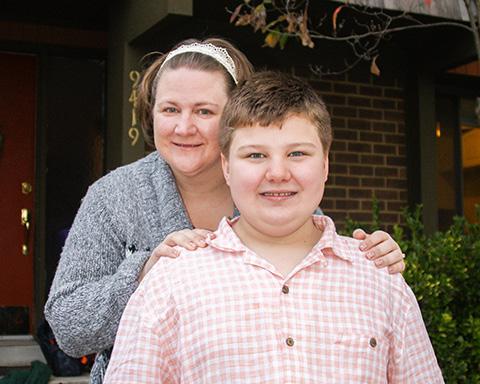Editor’s note: This article is the first in a series describing one NCI at Frederick parent’s perspective on special needs parenting.
By Melissa Porter, Staff Writer
My husband and I find calling ourselves “special needs parents” difficult. Yes, we do have a child who has autism, and yes, we approach each day differently, but I have never thought of that as special needs parenting.
When our son, Harrison, was an infant and toddler, he was progressing as he should have for his age. We noticed there were a couple of delays, but nothing that was too alarming, except for his speech. By the time he was three, we knew we needed to have him assessed, so we scheduled an assessment through Child Find, a nationwide special needs evaluation program.
The first assessment was a disaster. In this assessment, we took Harrison to a large gym that had multiple stations set up with various diagnostic tests. At the stations, children were asked to complete a variety of tasks, such as stacking blocks and lacing a board with string. Each station required the child to sit and attend to a task. Ever since Harrison had learned to walk, he was in constant motion, and we could not even get him to sit still to eat a meal. So sitting to attend to a task was not something he was going to do.
Therefore, we qualified for round two. Round two was less disastrous than the first assessment. In this round, we sat in a small room with one doctor. Our son was able to complete tasks such as stringing beads and stacking blocks to a certain height, and we were surprised to find out that he could complete many of these tasks. For example, he was a whiz at puzzles and was very particular about exactly matching up a picture and an object. The whole process was interesting to observe, and this was the first time we realized that our son was taking in much more of the world than he was letting on. This realization came as we watched him complete tasks that were not taught to him, but that he had observed other children or adults doing.
After all the testing concluded, we were able to enroll Harrison in a special preschool program. That was great, but we were left with many questions, including “OK, now what?” Our son did not fit neatly into any one diagnosis, which was both good and not so good. It was “good” because he was not labeled as having any one particular diagnosis or disability. But, it was also “bad” because we did not have a particular diagnosis for treating and learning to cope with his disabilities. The doctors said that he was simply “delayed.”
As a parent, you want to do everything you can to help your children, especially when you see them struggling. For a while, we were at a bit of a loss because we did not have a specific treatment plan, so we used trial and error to find what worked for Harrison.
As our son got older, we felt it was time to have another assessment, this time with a private health care provider. These assessments take approximately three hours to complete. Sitting for three hours and attending to a task are difficult whether you have autism or other needs, and are especially difficult for a six-year-old boy. After multiple trips to the doctor’s office, we finally had a genuine diagnosis: our son has pervasive developmental disorder–not otherwise specified (PDD-NOS). PDD-NOS is one of the diagnoses that fall on the autism spectrum.
What Is the Autism Spectrum?
Since our son was diagnosed in 2007 with an autism spectrum disorder (ASD), the statistics have increased from 1 in 110 children being diagnosed on the spectrum to 1 in 88 in 2008, according to the Centers for Disease Control and Prevention. In 2010, the number increased to 1 in 68 children diagnosed. The diagnosis is four to five times more common among boys (1 in 42) than girls (1 in 189). Research continues to try to answer many questions about ASD, such as why is there such a large prevalence of ASD, what causes ASD, and what therapies can be used to treat or improve ASD?
In May 2013, the fifth edition of the Diagnostic and Statistical Manual of Mental Disorders (DSM-5) was published. This is the tool used by health professionals for diagnosing autism. In previous versions of the manual, autism was recognized by various distinct subtypes, which included autistic disorder, childhood disintegrative disorder, PDD-NOS, and Asperger syndrome. In the DSM-5, all of these diagnoses have been merged under one umbrella diagnosis of ASD. So if you hear people speaking about the autism spectrum, this is what they are discussing.
You may also hear people say, “If you have met one child with autism, you have met one child with autism.” There are some common characteristics of autism that vary in their intensity. These characteristics include repetitive behaviors, nonverbal and verbal communication problems, and social interaction difficulties. However, each child affected by autism displays these characteristics differently, which is one of the biggest challenges of treating autism. There is no “one-size-fits-all” therapy and approach that works well.
As a parent, realizing that your child is not developing in the same way as others can be scary, and it is challenging to know where to start. There are many resources available with a wealth of information to help you on the journey to understanding disabilities like autism. The challenge is filtering through all the information available. With enough patience and motivation, parenting a special needs child is one of the most rewarding experiences.
More information may be found on the websites of the following public and private organizations:
Centers for Disease Control and Prevention
National Institute of Mental Health
National Institute of Neurological Disorders and Stroke
Next: Sorting through the information and navigating the Individual Education Plan process


